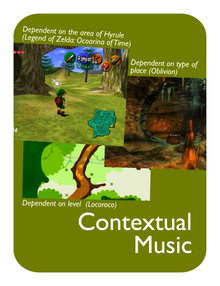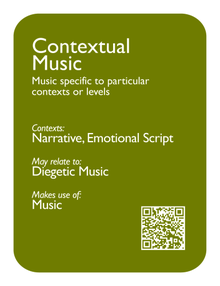Difference between revisions of "Contextual Music"
ValterAlves (Talk | contribs) m |
ValterAlves (Talk | contribs) m |
||
| (9 intermediate revisions by the same user not shown) | |||
| Line 2: | Line 2: | ||
| name =Contextual Music | | name =Contextual Music | ||
| deckversion =1.0 | | deckversion =1.0 | ||
| − | | | + | | v10synopsis =Music specific to particular contexts or levels |
| + | | v20synopsis =Music specific to particular contexts or levels | ||
| patternpresentation = | | patternpresentation = | ||
| cardpresentation= | | cardpresentation= | ||
| − | | | + | | v10frontface =ContextualMusic-front-v10.png |
| − | | | + | | v10backface =ContextualMusic-back-v10.png |
| + | | v20frontface =ContextualMusic-front-v20.png | ||
| + | | v20backface =ContextualMusic-back-v20.png | ||
| screenshots= | | screenshots= | ||
| − | | | + | | v10rel-tag1=Contexts:<br> |
| − | | | + | | v10rel1=[[Narrative]], [[Emotional Script]]<br> |
| − | | | + | | v10rel-tag2=May relate to:<br> |
| − | | | + | | v10rel2=[[Diegetic Music]]<br> |
| − | | | + | | v10rel-tag3=Makes use of:<br> |
| − | | | + | | v10rel3=[[Music]]<br> |
| + | | v20rel-tag1=Contexts:<br> | ||
| + | | v20rel1=[[Narrative]], [[Emotional Script]]<br> | ||
| + | | v20rel-tag2=May relate to:<br> | ||
| + | | v20rel2=[[Diegetic Music]]<br> | ||
| + | | v20rel-tag3=Makes use of:<br> | ||
| + | | v20rel3=[[Music]]<br> | ||
| revisions =Introduced in version 1.0 | | revisions =Introduced in version 1.0 | ||
| description = | | description = | ||
| − | [[Music]] is frequently used to | + | [[Music]] is frequently used to characterize specific contexts. These contexts may be regions in the scenario, levels, categories of circumstances, etc. |
Designing [[Contextual Music]] is more prone to contribute to the fitness of [[Music]] in each particular moment along the experience, than a "global" game [[Music]] alone would. The succession of the pieces of [[Contextual Music]], as heard by the player, allows a transposition to the [[Music]] level of the global [[Emotional Script]] of the experience. | Designing [[Contextual Music]] is more prone to contribute to the fitness of [[Music]] in each particular moment along the experience, than a "global" game [[Music]] alone would. The succession of the pieces of [[Contextual Music]], as heard by the player, allows a transposition to the [[Music]] level of the global [[Emotional Script]] of the experience. | ||
| − | [[Contextual Music]] may come from the game world itself ([[Diegetic Music]]) but that is | + | [[Contextual Music]] may come from the game world itself ([[Diegetic Music]]) but that is neither mandatory nor even the most frequent case. |
Also, [[Contextual Music]] may be designed so that the [[Variety]] it propitiates contributes to a constantly renewed experience. | Also, [[Contextual Music]] may be designed so that the [[Variety]] it propitiates contributes to a constantly renewed experience. | ||
| Line 27: | Line 36: | ||
| examples= | | examples= | ||
| − | | ex1 | + | | ex1=<mt p="ContextualMusic" g="Flower" w="{{R16by9W}}" h="{{R16by9H}}">An exploration of [[Contextual Music]] in the [[Menus]], to unfold the [[Emotional Script]] along the experience. In the beginning of the game the [[Menus|Menu]] presents an [[Acoustic Ecology]] (predominantly [[Ambiance]]) allusive to a emotionally negative environment. As the game progresses, it becomes more positive and eventually it becomes highly rewarding, which also supports very effectively the inherent [[Narrative]].</mt> |
| − | + | | ex2=<mt p="ContextualMusic" g="The Path" w="{{R32by17W}}" h="{{R32by17H}}"></mt> | |
| ex3=<mt p="ContextualMusic" g="LocoRoco" altg="LocoRoco" i=2 w="{{R16by9W}}" h="{{R16by9H}}">The contextuality of [[Music]] is impressive. It depends not only on the level but also on the selected type of LocoRoco (they are 6 and can be chosen in any level). Also, [[Music]] is adapted to the acoustics of the space (e.g., reverberation inside an ice cave). Even more interestingly, the more the LocoRoco the more the singing voices, which impacts considerably in the [[Emotional Script]]. The [[Variety]] provided by all this contextuality propitiates a constantly renewed experience.</mt> | | ex3=<mt p="ContextualMusic" g="LocoRoco" altg="LocoRoco" i=2 w="{{R16by9W}}" h="{{R16by9H}}">The contextuality of [[Music]] is impressive. It depends not only on the level but also on the selected type of LocoRoco (they are 6 and can be chosen in any level). Also, [[Music]] is adapted to the acoustics of the space (e.g., reverberation inside an ice cave). Even more interestingly, the more the LocoRoco the more the singing voices, which impacts considerably in the [[Emotional Script]]. The [[Variety]] provided by all this contextuality propitiates a constantly renewed experience.</mt> | ||
| − | | ex4=<mt p="ContextualMusic" g="Ocarina Of Time" altg="The Legend of Zelda:Ocarina of Time" w="{{R4by3W}}" h="{{R4by3H}}">Music is dependent on the map region.</mt> | + | | ex4=<mt p="ContextualMusic" g="Patapon" w="{{R16by9W}}" h="{{R16by9H}}"></mt> |
| + | | ex5=<mt p="ContextualMusic" g="Ocarina Of Time" altg="The Legend of Zelda: Ocarina of Time" w="{{R4by3W}}" h="{{R4by3H}}">Music is dependent on the map region.</mt> | ||
| + | | ex6=<mt p="ContextualMusic" g="Oblivion" altg="The Elder Scrolls IV: Oblivion" w="{{R16by9W}}" h="{{R16by9H}}">Music depends on space and highly related to the kind of emotions those spaces have to offer. In this example the change in the [[Emotional Script]] is perceptible.</mt> | ||
}} | }} | ||
Latest revision as of 19:32, 24 August 2012

|

| |
| The card's front face | The card's back face |
Contents
Synopsis
| Music specific to particular contexts or levels. |
Relationships
Contexts:
Narrative ![]() , Emotional Script
, Emotional Script ![]() .
.
May relate to:
Diegetic Music ![]() .
.
Makes use of:
Music ![]() .
.
Description
Music is frequently used to characterize specific contexts. These contexts may be regions in the scenario, levels, categories of circumstances, etc.
Designing Contextual Music is more prone to contribute to the fitness of Music in each particular moment along the experience, than a "global" game Music alone would. The succession of the pieces of Contextual Music, as heard by the player, allows a transposition to the Music level of the global Emotional Script of the experience.
Contextual Music may come from the game world itself (Diegetic Music) but that is neither mandatory nor even the most frequent case.
Also, Contextual Music may be designed so that the Variety it propitiates contributes to a constantly renewed experience.
A particular type of contextual variations on Music that we are addressing separately is the change according to the current involvement in the game's conflict. Those explorations are integrated in the design of Relaxation, Anticipation, Engagement and Decay.
Examples
  Flower: An exploration of Contextual Music in the Menus, to unfold the Emotional Script along the experience. In the beginning of the game the Menu presents an Acoustic Ecology (predominantly Ambiance) allusive to a emotionally negative environment. As the game progresses, it becomes more positive and eventually it becomes highly rewarding, which also supports very effectively the inherent Narrative.
|
  LocoRoco: The contextuality of Music is impressive. It depends not only on the level but also on the selected type of LocoRoco (they are 6 and can be chosen in any level). Also, Music is adapted to the acoustics of the space (e.g., reverberation inside an ice cave). Even more interestingly, the more the LocoRoco the more the singing voices, which impacts considerably in the Emotional Script. The Variety provided by all this contextuality propitiates a constantly renewed experience.
|
  The Elder Scrolls IV: Oblivion: Music depends on space and highly related to the kind of emotions those spaces have to offer. In this example the change in the Emotional Script is perceptible.
|


